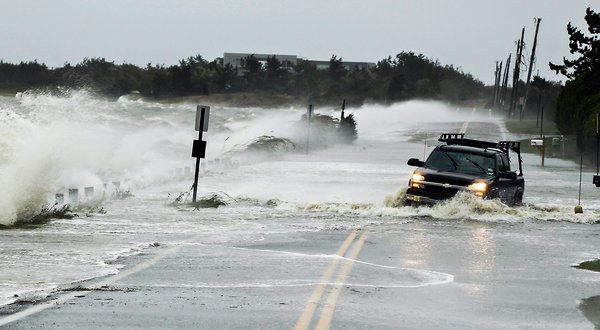A superstorm threatening 50 million people in the most heavily populated corridor in the nation gained strength Monday, packing winds of 90 mph and picking up considerable speed just hours before it is expected to make landfall, forecasters said.
The National Hurricane Center said Monday afternoon that Hurricane Sandy is moving northwest at 28 mph – up from 18 mph a few hours earlier. At 4:00 p.m. ET the Category 1 hurricane was about 55 miles east-southeast of Cape May, N.J. The storm’s top sustained winds are holding at about 90 mph with higher gusts.
Gale/tropical storm-force force winds were reported from North Carolina to southern New England.
Hours before the storm made landfall, high winds had already knocked out power to more than half a million customers in several states by mid-day Monday.
Sandy is expected to hook inland Monday, colliding with a wintry storm moving in from the west and cold air streaming down from the Arctic. Forecasters say the storm’s center will make landfall along or just south of the Southern New Jersey coast Monday evening.
CBS News hurricane consultant David Bernard reports that wind gusts of 38 mph and 41 mph have already been reported in New York City and Boston, respectively.
Sandy is likely going to strengthen even more as it approaches the East Coast, Bernard reports, with hurricane-force winds reaching land by Monday afternoon. The storm’s pressure is dropping, which means it’s growing in strength.
Flooding will be a huge threat, with many areas potentially seeing rainfall amounts between 5 and 8 inches over a 48-hour period.
The full moon will make storm surges worse, as high tides along the Eastern Seaboard will rise about 20 percent higher than normal.
Correspondent Chip Reid reports from Ocean City, Md., that sea levels could rise 8 feet above normal – enough to flood much of the city.

In addition to rains and flooding, about 2 to 3 feet of snow is forecast for mountainous parts of West Virginia.
- Full moon could make Hurricane Sandy impact worse
- Are you prepared for Hurricane Sandy? CDC has tips
- How to keep your food safe if Hurricane Sandy cuts electricity
- 10 costliest U.S. hurricanes
The tempest could endanger up to 50 million people for days. “This is the worst-case scenario,” said Louis Uccellini, environmental prediction chief for the National Oceanic and Atmospheric Administration.
President Barack Obama delivered a sober warning to millions in the path of the storm on Monday, appealing to those who have not evacuated to do so.
Obama on Hurricane Sandy: Please listen to state and local officials
“Please listen to what your state and local officials are saying. When they tell you to evacuate, you need to evacuate. Don’t delay, don’t pause, don’t question the instructions that are being given, because this is a powerful storm.”
From Washington to Boston, big cities and small towns were buttoned up against the onslaught of Sandy, with forecasters warning that the New York area could get the worst of it — an 11-foot wall of water.
“There’s a lot of people that are going to be under the impacts of this,” Federal Emergency Management Administrator Craig Fugate said on “CBS This Morning” Monday.
“You know, we’ve got blizzard warnings as far west as West Virginia, Appalachian Mountains, but I think the biggest concern right now are the people in the evacuation areas. They’re going to face the most immediate threats with the storm surge.”
“The biggest challenge is going to be not knowing exactly where the heaviest-hit areas are going to be,” said Fugate, “and the fact the storm’s going to take several days to move through the area with heavy rain and wind, so that’s going to slow down recovery activities like utility crews getting out and putting power back up.”
The U.S. Coast Guard rescued 14 members of a crew forced to abandon a tall shipabout 90 miles off the North Carolina coast and continued to search for two other crew members. The storm lashed barrier islands and rendered several homes and businesses nearly inaccessible.

Hurricane Sandy slams Northeast
Forecasters said the hurricane could blow ashore Monday night along the New Jersey coast, then cut across into Pennsylvania and travel up through New York State on Wednesday. As the storm closed in, a crane dangled precariously in the wind off a 65-story luxury building in New York City, and the streets were cleared as a precaution.
Forecasters said the combination of Sandy with the storm from the west and the cold air from the Arctic could bring close to a foot of rain in places, a potentially lethal storm surge of 4 to 11 feet across much of the region, and punishing winds that could cause widespread power outages that last for days. The storm could also dump up to 2 feet of snow in Kentucky, North Carolina and West Virginia.






























